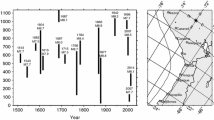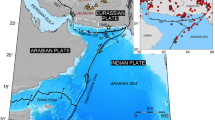Abstract
The lack of offshore seismic data caused uncertainties associated with understating the behavior of future tsunamigenic earthquakes in the Makran subduction zone (MSZ). Future tsunamigenic events in the MSZ may trigger significant near-field tsunamis. Tsunami wave heights in the near field are controlled by the heterogeneity of slip over the rupture area. Considering a non-planar geometry for the Makran subduction zone, a range of random \(k^{-2}\) slip models were generated to hypothesize rupturing on the fault zone. We model tsunamis numerically and assess probabilistic tsunami hazard in the near field for all synthetic scenarios. The main affected areas by tsunami waves are the area between Jask and Ormara along the shorelines of Iran and Pakistan and the area between Muscat and Sur along the Oman coastline. The maximum peak-wave height along the shores of Iran and Pakistan is about 16 m and about \(12{\text{m}}\) for the Oman shoreline. The slip distributions control the wave height along the Makran coastlines. The dependency of tsunami height on the heterogeneity of slip is higher in the most impacted areas. Those areas are more vulnerable to tsunami hazard than other areas.










Similar content being viewed by others

References
Barkan R, ten Brink U (2010) Tsunami simulations of the 1867 Virgin Island earthquake: constraints on epicenter location and fault parameters. Bull Seismol Soc Am 100(3):995–1009
Barkan R, ten Brink US, Lin J (2009) Far field tsunami simulations of the 1755 Lisbon earthquake: implications for tsunami hazard to the U.S. East Coast and the Caribbean. Mar Geol 264(1–2):109–122
Becker JJ, Sandwell DT, Smith WHF, Braud J, Binder B, Depner J, Fabre D, Factor J, Ingalls S, Kim S-H, Ladner R, Marks K, Nelson S, Pharaoh A, Trimmer R, Rosenberg JV, Wallace G, Weatherall P (2009) Global bathymetry and elevation data at 30 arc seconds resolution: SRTM30_PLUS. Mar Geod 32(4):355–371
Bernard P, Herrero A (1994) Slip heterogeneity, body-wave spectra, and directivity of earthquake ruptures. Annali di Geofisica XXXVII:1679–1690
Byrne DE, Sykes LR, Davis DM (1992) Great thrust earthquakes and aseismic slip along the plate boundary of the Makran Subduction Zone. J Geophys Res 97(B1):449
Cosentino P, Ficarra V, Luzio D (1977) Truncated exponential frequency-magnitude relationship in earthquakes statistics. Bull Seismol Soc Am 67(6):1615–1623
Downes GL, Stirling MW (2001) Groundwork for development of a probabilistic tsunami hazard model for New Zealand. In: Bernard E (ed) International Tsunami symposium 2001. Pacific Marine Environmental Lab, Seattle, Wash, pp 293–301
Dutykh D, Labart C, Mitsotakis D (2011) Long wave run-up on random beaches. Phys Rev Lett 107(18):184504
Dutykh D, Mitsotakis D, Chubarov LB, Shokin YI (2012) On the contribution of the horizontal sea-bed displacements into the tsunami generation process. Ocean Model 56:43–56
El-Hussain I, Omira R, Deif A, Al-Habsi Z, Al-Rawas G, Mohamad A, Al-Jabri K, Baptista MA (2016) Probabilistic tsunami hazard assessment along Oman coast from submarine earthquakes in the Makran subduction zone. Arab J Geosci 9(15):668
Fujii Y, Satake K, Sakai S, Shinohara M, Kanazawa T (2011) Tsunami source of the 2011 off the Pacific coast of Tohoku Earthquake. Earth Planets Space 63(7):815–820
Gallovič F, Brokešová J (2004) The k-2 rupture model parametric study: example of the 1999 Athens earthquake. Stud Geophys Geod 48(3):589–613
Geist EL (2002) Complex earthquake rupture and local tsunamis. J Geophys Res 107(B5):2086
Geist EL, Dmowska R (1999) Local Tsunamis and distributed slip at the source. Pure Appl Geophys 154(3–4):485–512
Geist EL, Parsons T (2006) Probabilistic analysis of tsunami hazards. Nat Hazards 37(3):277–314
González FI, Geist EL, Jaffe B, Kânoǧlu U, Mofjeld H, Synolakis CE, Titov VV, Areas D, Bellomo D, Carlton D, Horning T, Johnson J, Newman J, Parsons T, Peters R, Peterson C, Priest G, Venturato A, Weber J, Wong F, Yalciner A (2009) Probabilistic tsunami hazard assessment at Seaside, Oregon, for near-and far-field seismic sources. J Geophys Res Oceans 114(11):C11023
Greenslade DJ, Titov VV (2008) A comparison study of two numerical tsunami forecasting systems. Pure Appl Geophys 165(11–12):1991–2001
Grezio A, Gasparini P, Marzocchi W, Patera A, Tinti S (2012) Tsunami risk assessments in Messina, Sicily—Italy. Nat Hazards Earth Syst Sci 12(1):151–163
Gutenberg B, Richter C (1954) Seismicity of the earth and associated phenomena. Princeton University Press, Princeton
Gutscher M-A, Westbrook GK (2009) Great earthquakes in slow-subduction, low-taper margins. In: Lallemand S, Funiciello F (eds) Subduction zone geodynamics. Springer, Berlin, pp 119–133
Heidarzadeh M, Kijko A (2011) A probabilistic tsunami hazard assessment for the Makran subduction zone at the northwestern Indian Ocean. Nat Hazards 56(3):577–593
Heidarzadeh M, Pirooz MD, Zaker NH, Synolakis CE (2008a) Evaluating tsunami hazard in the Northwestern Indian Ocean. Pure Appl Geophys 165(11–12):2045–2058
Heidarzadeh M, Pirooz MD, Zaker NH, Yalciner AC, Mokhtari M, Esmaeily A (2008b) Historical tsunami in the Makran Subduction Zone off the southern coasts of Iran and Pakistan and results of numerical modeling. Ocean Eng 35(8–9):774–786
Heidarzadeh M, Satake K (2014) Possible sources of the tsunami observed in the northwestern Indian Ocean following the 2013 September 24 Mw 7.7 Pakistan inland earthquake. Geophys J Int 199(2):752–766
Hoechner A, Babeyko AY, Zamora N (2016) Probabilistic tsunami hazard assessment for the Makran region with focus on maximum magnitude assumption. Nat Hazards Earth Syst Sci 16(6):1339–1350
Horspool N, Pranantyo I, Griffin J, Latief H, Natawidjaja DH, Kongko W, Cipta A, Bustaman B, Anugrah SD, Thio HK (2014) A probabilistic tsunami hazard assessment for Indonesia. Nat Hazards Earth Syst Sci 14(11):3105–3122
Huang Z, Wu T-R, Tan SK, Megawati K, Shaw F, Liu X, Pan T-C (2009) Tsunami hazard from the subduction megathrust of the south china sea: part ii. Hydrodynamic modeling and possible impact on singapore. J Asian Earth Sci 36(1):93–97
Ide S, Baltay A, Beroza GC (2011) Shallow dynamic overshoot and energetic deep rupture in the 2011 M w 9.0 Tohoku-Oki earthquake. Science 332(6036):1426–1429
Lay T, Ammon CJ, Kanamori H, Yamazaki Y, Cheung KF, Hutko AR (2011) The 25 October 2010 Mentawai tsunami earthquake (Mw 7.8) and the tsunami hazard presented by shallow megathrust ruptures. Geophys Res Lett 38(6):L06302
Li L, Qiu Q, Huang Z (2012) Numerical modeling of the morphological change in lhok nga, west banda aceh, during the 2004 indian ocean tsunami: understanding tsunami deposits using a forward modeling method. Nat Hazards 64(2):1549–1574
Lin I-C, Tung CC (1982) A preliminary investigation of tsunami hazard. Bull Seismol Soc Am 72(6A):2323
Liu PL-F, Woo S-B, Cho Y-S (1998) Computer programs for tsunami propagation and inundation. Technical report, School of Civil and Environmental Engineering, Cornell University
Musson R (2009) Subduction in the Western Makran: the historian's contribution. J Geol Soc 166(3):387–391
Okada Y (1985) Surface deformation due to shear and tensile faults in a half-space. Bull Seismol Soc Am 75:1135–1154
Okal EA, Synolakis CE (2008) Far-field tsunami hazard from mega-thrust earthquakes in the Indian Ocean. Geophys J Int 172(3):995–1015
Parsons T (2008) Monte Carlo method for determining earthquake recurrence parameters from short paleoseismic catalogs: Example calculations for California. J Geophys Res Solid Earth 113(3):B03302
Priest G, Goldfinger C, Wang K, Witter R, Zhang Y, Baptista A (2009) Special paper 41: tsunami hazard assessment of the northern Oregon Coast: a multi-deterministic approach tested at Cannon Beach, Clatsop County. Oregon. AGU Fall Meeting Abstracts 1–100
Rajendran CP, Rajendran K, Shah-hosseini M, Beni AN, Nautiyal CM, Andrews R (2013) The hazard potential of the western segment of the Makran subduction zone, northern Arabian Sea. Nat Hazards 65(1):219–239
Rajendran CP, Ramanamurthy MV, Reddy NT, Rajendran K (2008) Hazard implications of the late arrival of the 1945 Makran tsunami. Curr Sci 95(12):1739–1743
Rashidi A, Shomali ZH, Dutykh D, Keshavarz Farajkhah N (2018) Evaluation of tsunami wave energy generated by earthquakes in the Makran subduction zone. Ocean Eng (submitted)
Rehman SU, Khalid M, Ali A, Abd El-Aal AE-AK (2013) Deterministic and probabilistic seismic hazard analysis for Gwadar City, Pakistan. Arab J Geosci 6(9):3481–3492
Rikitake T, Aida I (1988) Tsunami hazard probability in Japan. Bull Seismol Soc Am 78(3):1268–1278
Ruiz JA, Fuentes M, Riquelme S, Campos J, Cisternas A (2015) Numerical simulation of tsunami runup in northern Chile based on non-uniform k2slip distributions. Nat Hazards 79(2):1177–1198
Satake K (2014) Advances in earthquake and tsunami sciences and disaster risk reduction since the 2004 Indian ocean tsunami. Geosci Lett 1(1):15
Smith WH, Sandwell DT (1997) Global sea floor topography from satellite altimetry and ship depth soundings. Science 277(5334):1956–1962
Smith G, McNeill L, Henstock TJ, Bull J (2012) The structure and fault activity of the Makran accretionary prism. J Geophys Res 117:B07407
Smith GL, McNeill LC, Wang K, He J, Henstock TJ (2013) Thermal structure and megathrust seismogenic potential of the Makran subduction zone. Geophys Res Lett 40(8):1528–1533
Somerville P, Irikura K, Graves R, Sawada S, Wald D, Abrahamson N, Iwasaki Y, Kagawa T, Smith N, Kowada A (1999) Characterizing crustal earthquake slip models for the prediction of strong ground motion. Seismol Res Lett 70(1):59–80
Sørensen MB, Spada M, Babeyko A, Wiemer S, Grünthal G (2012) Probabilistic tsunami hazard in the Mediterranean Sea. J Geophys Res Solid Earth 117(B1):B01305
Suppasri A, Shuto N, Imamura F, Koshimura S, Mas E, Yalciner AC (2013) Lessons learned from the 2011 Great East Japan tsunami: performance of tsunami countermeasures, coastal buildings, and tsunami evacuation in Japan. Pure Appl Geophys 170(6–8):993–1018
Syamsidik Tursina, Suppasri A, Al'ala M, Luthfi M, Comfort LK (2019) Assessing the tsunami mitigation effectiveness of the planned banda aceh outer ring road (borr), indonesia. Nat Hazards Earth Syst Sci 19(1):299–312
Tang L, Chamberlin C, Tolkova E, Spillane M, Titov VV, Bernard EN, Mofjeld HO (2006) Assessment of Potential Tsunami Impact for Pearl Harbor, Hawaii. NOAA Technical Memorandum OAR PMEL-136 2984(August):1–42
Wang X, Liu PLF (2005) A numerical investigation of Boumerdes-Zemmouri (Algeria) earthquake and Tsunami. CMES Comput Model Eng Sci 10(2):171–183
Wang X, Liu PL-F (2006) An analysis of 2004 Sumatra earthquake fault plane mechanisms and Indian Ocean tsunami. J Hydraul Res 44(2):147–154
Weichert DH (1980) Estimation of the earthquake recurrence parameters for unequal observation periods for different magnitudes. Bull Seismol Soc Am 70(4):1337–1346
Wessel P, Smith WHF (1991) Free software helps map and display data. Eos Trans Am Geophys Union 72(41):441–446
Yamazaki Y, Cheung KF (2011) Shelf resonance and impact of near-field tsunami generated by the 2010 Chile earthquake. Geophys Res Lett 38(12):L12605
Yamazaki Y, Lay T, Cheung KF, Yue H, Kanamori H (2011) Modeling near-field tsunami observations to improve finite-fault slip models for the 11 March 2011 Tohoku earthquake. Geophys Res Lett 38(20):L00G15
Acknowledgements
We would like to thank the developers of Comcot numerical model (Liu et al. 1998). Figures were drawn using the GMT software (Wessel and Smith 1991). We would like to express special thanks to the Editor, Prof. Thomas Glade and two anonymous reviewers for their constructive and thoughtful comments. A. Rashidi would like to acknowledge the hospitality of the Department of Earth Sciences, Uppsala University, Sweden, and the Laboratory of Mathematics (LAMA UMR 5127), University Savoie Mont Blanc, France.
Author information
Authors and Affiliations
Corresponding author
Additional information
Publisher's Note
Springer Nature remains neutral with regard to jurisdictional claims in published maps and institutional affiliations.
Rights and permissions
About this article
Cite this article
Rashidi, A., Shomali, Z.H., Dutykh, D. et al. Tsunami hazard assessment in the Makran subduction zone. Nat Hazards 100, 861–875 (2020). https://doi.org/10.1007/s11069-019-03848-1
Received:
Accepted:
Published:
Issue Date:
DOI: https://doi.org/10.1007/s11069-019-03848-1



